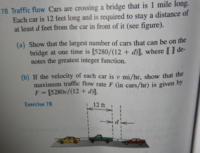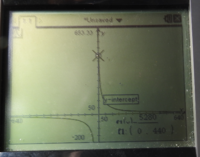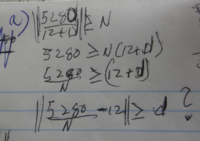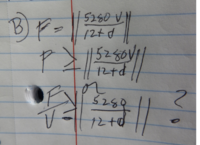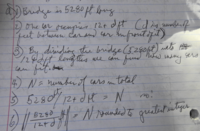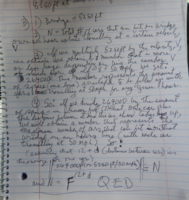I don't know what the
author expected; this is not what
I was leading you toward, but your work for part (a) is not inappropriate, and you do seem to have the right picture in mind. (I think my suggestion is better for a more complicated problem, and therefore worth learning to do.) The tricky part in your approach is perhaps in deciding for sure which direction to round. Your answer isn't quite right in that regard.
Here is the inequality approach I had in mind:
Suppose there are n cars on the bridge. Then if each one takes up 12 + d feet, then all together they take up n(12 + d) feet, right? (Otis and I both alluded to a slight inaccuracy here, but I'll let it go, since this will lead to their answer.
Now, if they all fit on the bridge, this distance must be no more than the length of the bridge:
n(12 + d) ≤ 5280
Solving for n, we get
n ≤ 5280/(12 + d)
Now, what is the largest number of cars that can fit? It's the largest integer that is no greater than that RHS. That's what the greatest integer function means:
n = [[5280/(12 + d)]]
(Your notation isn't what they intended. It's not a double absolute value, like ||x||, but a double bracket, like [[x]], which denotes, as they say, the "greatest integer function" -- that is the greatest integer that is not greater than x. It means, that is, to round down (not "to the greatest integer", which sounds like it means rounding up. Some people just use [x], though that can be
mcdvoice misleading; others use floor(x) or [MATH]\lfloor x \rfloor[/MATH] with the same meaning.)
As I suggested, using an inequality makes it a little easier to be sure how to round, though I imagine you actually meant the right thing.
Now see if you can make your answer to part (b) a little more convincing. Use the letter F and v throughout, rather than using a specific number but popping F in there magically at the end and never getting back to v at all. The right ideas are there, but a proof has to prove, not just suggest. (Yes, their word is "show", but you have to really
show.)
